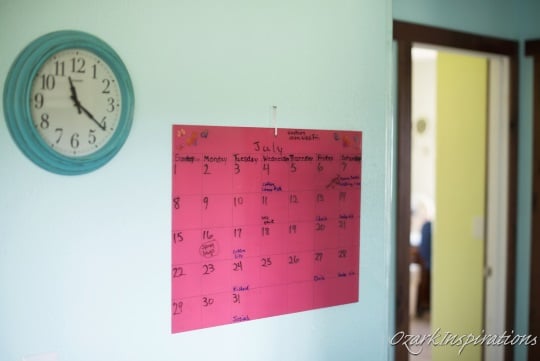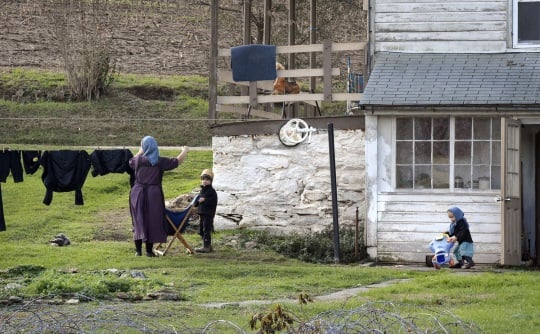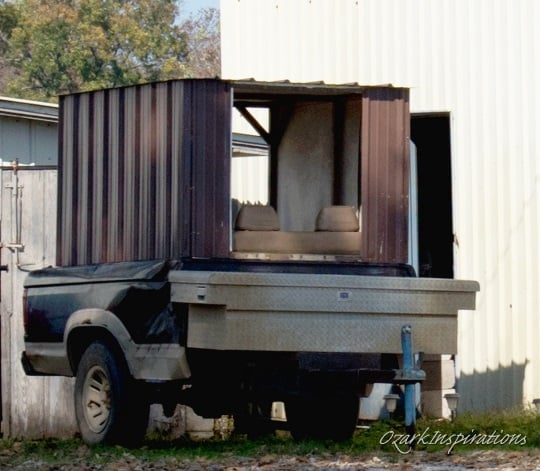The Eight States With A Single Amish Settlement (2017)

Some states are known for having large Amish populations spread across many communities.
Places like Ohio, Wisconsin, and New York each have dozens of individual settlements (see our list of the top 10 states by Amish population).
But there is another group of Amish-settled states – those with just a single community.
Some of these are long-established – like the community at Dover, Delaware, on the map since 1915.
Others are recently settled, and have no assurance of sticking around, given the long history of extinct Amish settlements.
States With Only One Amish Community
Here they are (listed in order of estimated size):
1. Delaware – By far the largest community in a single-settlement state, Approximately 1,600 Amish live in the vicinity of Dover (estimate via the Amish Studies website). Amish in the Dover community have buggies with a distinctive shape. Though it’s been here for over a century, this community has faced land pressure due to its proximity to the state capital. Amish from Dover have founded daughter settlements, including in Halifax County, VA. Read more on the Dover Amish community.
2. Mississippi – The small community at Randolph (Pontotoc County) is a plain Swartzentruber Amish settlement. Amish first settled here in 1995, and the community has since grown to two church districts in size. The settlement has ties to the Ethridge, Tennessee Amish community. Read more on the Amish in Mississippi.
3. Wyoming – Amish moved to America’s least-populous state in the early 2010s, settling in Crook County (Hulett). This community is a single church district in size.

4. Florida – Of all the single-community states, Florida’s Amish have gotten the most public attention. This is mainly due to the unusual nature of the community. The Pinecraft settlement, basically located within the city of Sarasota, is a haven for Amish vacationers who flock to the area in the chillier months. There is also a small permanent year-round population. Read more on the Amish at Pinecraft.
5. Idaho – Idaho’s sole church district is officially known as “Salmon River”, suggesting there might be some pretty solid fishing in the area. Perhaps that factored into the decision to move to this remote territory, located near the town of Salmon in Lehmi County.
6. South Dakota – A small band of Amish made the trek here from Wisconsin in 2010, deciding on Hutchinson County (Tripp) as their new home. Read more here.

7. Texas – The Beeville (Bee County) community has popped up on this website regularly over the past several years. Each year the Beeville Amish have an auction to benefit their parochial school. The best-known business here is probably Borntrager’s Combination Shop, run by the settlement’s bishop. Amish came to this corner of south Texas in 1999. Amish had previously tried to settle in Texas on several other occasions, though none of those communities were very long-lived. Read more on Amish in the Lone Star State.
8. Vermont – Several Amish families settled in Orleans County in 2015. This community has the smallest estimated population at just 40 individuals, suggesting that there are probably no more than 6-8 households here.
Worth mentioning
There is also one state which long had only a single settlement, but recently moved off this list – North Carolina.
The Tar Heel State added a community in the area of Ellenboro/Polkville in 2015. The oldest NC community, at Union Grove, has been around since the mid-1980s.
We can also add one Canadian province – New Brunswick – and 2 countries – Argentina and Bolivia – if we want to include non-state locations with just one community. All of these places have seen their sole Amish communities established in the past several years.








This is interesting information. I’d like to learn a little more about the present status of the Amish settlement at Pinecraft in Sarasota, Florida. Are there now two districts at Pinecraft? In the winter months in scribes’ news from Pinecraft I believe that I’ve read that there are so many Amish there in the winter months that on some church Sundays they have Amish services at three locations in Pinecraft.
Two church districts at Pinecraft
Al, interesting question, I just checked the latest Almanac and it looks like there are 2 districts now – “Pinecraft”, and “Pinecraft 2”.
The Amish Studies site only has an estimated population of 75 for this community (which would be on the small side for even a single district), but I guess this could be a special case of having two separate districts to accommodate the many winter visitors as you suggest.
As for the locations, there is the Pinecraft Amish Church which is its own building (see 2 photos near the bottom of this post: https://amishamerica.com/visiting-pinecraft/). Not totally sure if the Mennonite Tourist Church is one of the others, but maybe someone here would be able to confirm.
Thanks for your further info, Erik. I must have remembered correctly from The Budget that there are now two districts. It’s interesting that there are now enough Amish there year round to have two districts. I will be on the lookout in issues of The Budget this winter in heavy tourist season, to see if they meet in 3 locations this winter. I was thinking the third location may be in Pinecraft Park, but don’t think it’s Tourist Church.
Reading about Tourist Mennonite Church in The Budget is also interesting. In the winter, attendance each Sunday in heavy tourist season is reported to be several hundred, then after the tourists all leave in the spring, attendance can go down to less than fifty.
Interesting Al, thanks. Will be glad to hear anything you learn.
Arkansas?
Eric, last I knew AR only had one Amish community — Salem — after the Rector (sp?) community disbanded. Is there now another on in my home state that I need to go check out? 😉
Erik -- not Eric. Sorry.
oops.
No prob Don – I answer to many things:) There are 2 settlements now, I need to have a glance at the Almanac to see if the 2nd is listed but I’m away from it now. But will look and let you know.
No hurry. But I am curious about what “almanac” you are referring to.
Well I checked, and the latest Raber’s Almanac actually still lists Rector as existing with a Noah Hochstetler as Bishop (he’s the only minister listed). I know in your post on this community, you mentioned that a Hochstetler was the last known Amish resident and was waiting to sell his farm before moving. https://amishamerica.com/a-visit-to-an-amish-ghost-town/
Perhaps it is still listed in the 2017 edition in error. And it’s possible that this Rector community is extinct but there is a second one that the Amish Studies site is counting, but that was not included in the Almanac (it’s pretty comprehensive but doesn’t always list every last district).
Raber’s Almanac is also known officially as The New American Almanac. Among other things it lists info on Amish church districts and their ministry, and is produced by Raber’s Bookstore of Baltic, OH. The German language name is Der Neue Amerikanische Calender. A couple of posts we’ve had on this publication in the past:
https://amishamerica.com/amish-almanac-calender-tale/
https://amishamerica.com/rabers-amish-almanac/
Thanks. May have to keep my open for a copy.
Thank you for the information. I do wish the Amish/mennonite communities would settle out here in Bay Area California. The closest anabaptist Churches are two hours away at the least!
Chelsea, maybe that will happen someday 🙂 As far as the Amish are concerned, they’ve only tried to settled in California once, a very short-lived settlement over 100 years ago: https://amishamerica.com/california-amish-community/
Amish in Texas
I did have a nice talk with the Bishop of the Amish group in Beeville, TX. Compared to other communities, they are not as clean cut. Don’t mean to be judgmental, but the area is just more “trashy” than any others I have seen. When I mentioned Amish friends I have in Lancaster, PA, the Bushop said they were the rich Amish.
They provide produce to a grocery chain, so soil in the area must be good, but can’t compare to the rich soil of Lancaster County, PA. I hope they will stay & hope they are able to make a living. Their annual “sale” does well.
Thanks for sharing this Bob. That is the impression I’ve gotten from your photos and other info. I don’t think I’ve heard the term “rich Amish” used for Lancaster County people, but I guess compared to how things appear in Bee County, that would be apt. I doubt the typical farm in that part of Texas is going for $1 million-plus.
Bob, I’ve experienced some of the same. I’ve been a couple of times in the Seymour community, and it is a whole different world than their “mother” community in Berne, IN (I think it is). Berne has some of the most well-kept homes and yards I’ve seen among the Amish, but Seymour is anything but. Looks more like something from the backwoods or remote hillbilly regions. I’ve heard someone use the term “low Amish” for those opting to live like this — and I’m told that they wear the label with honor, thinking that living in meager circumstances here (even though they may have considerable personal financial resources) is a sign of their humility before God and others. I’m not sure if this is the same as what you mean by “trashy,” but it certainly does seem like a fitting term describing how they choose to live.
My very first experience with an Amish man was near Charm, OH. He was curious about our trip that was going to take us on into Lancaster Co. I don’t remember his exact words, but his view of the PA Amish was very similar to the Bishop you mentioned who considered them the “rich” Amish.
It’s always of interest to me to learn about the smaller Amish communities and how they’re faring. For say, an established Midwest community to up and move out west must be somewhat akin to the experiences of some of the early settlers during our country’s westward expansion. Exciting, but frightening!
Speaking of Pinecraft, what impact, if any, have recent hurricanes had on the Amish population there? Does anyone know?
Alice Mary
Pinecraft hurricane damage after Irma
Some people have been wondering about that Alice Mary – I added a comment on this based on info from Katie Troyer following Irma. In a nutshell, there was some damage, but nothing catastrophic. You can read the whole thing and get links to Katie’s site and photos on the hurricane here:
https://amishamerica.com/florida-amish/comment-page-1/#comment-172800
New NC Mennonite Community
Hi Erik, I live in Moore County NC. we have a new Mennonite Community that has settled in the High Falls area. It has been neat to see them set up there Kettle Corn and Storage Building Business. I am from Lancaster PA Originally so seeing them helps me to feel a little more at home.
Amish - Maine
We have Amish near
My hometown in Easton & Fort Fairfield Maine. They are seen all over working their fields and taking the buggies into town. Do you have information on them?